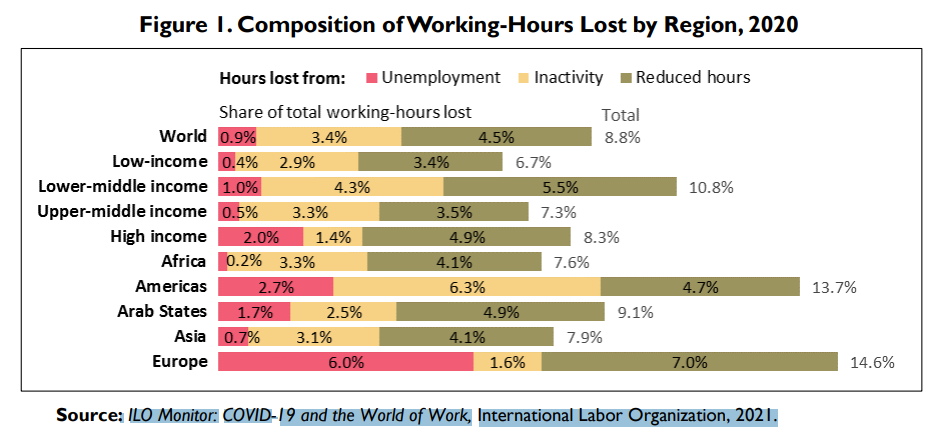The COVID-19 pandemic is an unprecedented worldwide phenomenon and a deeply personal experience with far-reaching consequences. On September 20, 2021, viral fatalities in the United States exceeded the 675,446 total from the 1918 Spanish flu, the previous greatest pandemic-related fatality total in the United States. The epidemic has disrupted life in all nations and communities and negatively impacted global economic development in 2020 that is unprecedented in over a century. According to estimates, the virus lowered global economic growth in 2020 to an annualized rate of roughly -3.2 percent, with a 5.9 percent rebound in 2021. Global trade was estimated to have fallen by 5.3% in 2020 but was projected to grow by 8.0% in 2021. According to mainstream projections, the economic slump in 2021 was less severe than previously anticipated, thanks to fiscal and monetary policies implemented by governments in 2021.
Economic growth in most nations decreased drastically in the second quarter of 2020, swiftly recovered in the third quarter, and has mainly been positive thereafter. Although the overall global economic consequences are reducing, they are still significant. The chronic nature of the health crisis, in particular, is hurting the global economy in ways that go beyond standard metrics, with potentially long-term and far-reaching consequences. Economic estimates reflect the continued dangers to a long-term global recovery presented by a comeback of contagious diseases, as well as possible inflationary pressures associated with pent-up consumer demand powered by an increase in human savings. On the supplier side, shortages reflect ongoing labour market disturbances, manufacturing and supply network bottlenecks, disturbances in global energy markets, and transportation and logistics impediments, all of which contribute to rising inflation.
In contrast to the synchronized nature of the global economic slowdown in the first half of 2020, the global economy has shown signs of a two-track recovery, which began in the third quarter of 2020 and has been marked by a nascent recovery in developed economies with high vaccination rates, but a slower rate of growth in developing economies with low vaccination rates. As several developed economies begin to recover, financial institutions and government bodies are balancing the impact and timing of withdrawing monetary and fiscal support due to worries about possible inflationary pressures versus the risk of delaying the speed of recovery. These worries are exacerbated by the advent of novel disease types and rolling epidemic hotspots, which pose a challenge to national attempts to limit infections and completely restore economic activity. Major developed economies, which account for 60% of the world economy, are expected to function below their potential production level until at least 2024, implying reduced individual and national economic wellbeing compared to pre-pandemic levels.
Overall, industrialized nations have made progress in vaccinating increasing proportions of their populations, enhancing the potential of a durable economic rebound in late 2021 and early 2022, and, as a result, a recovery in the global economy. However, novel COVID-19 viral variations and an increase in identified cases in big emerging economies, and vaccine resistance in select populations in established economies raise concerns regarding the speed and intensity of an economic recovery soon. A return of infectious cases across Europe, Latin America, Russia, the United States, Japan, Brazil, India, and most of Africa prompted calls for lockdowns and curfews, threatening to undermine or postpone a possible durable economic recovery beyond late 2021.
The economic repercussions from the epidemic have had a divergent impact on various sectors of the economy, notably the service sector and specific demographic groups, and might result in more labour dislocations. Workers evaluate their career paths and work patterns in certain situations, which may signal post-pandemic economies with more diverse labour arrangements and changing metropolitan surroundings.
The pandemic has touched everyone, from corporations to people. While we all know that many have had a rough time, others have managed to turn their fortunes around. In reality, many firms benefit from some extremely beneficial improvements that have sprung from the circumstance. There is no doubting that the way we do work has changed, but it has changed for the better in many respects. During this unique period, we have seen organizations and workers adopt new abilities and develop new behaviours that have changed how we operate in workplaces. Many firms have managed to utilize the COVID-19 epidemic as a chance for change, but how has this year helped to improve the way we work?
The pandemic has had a huge impact on the workplace environment. The worldwide lockdown and travel prohibitions have challenged long-held beliefs about the nature of labour and business connections. People have realized that they do not need to be at an office and can complete most tasks remotely. They dont have to drive to work. Others have transitioned from jet-set to residence with no impact on their business. The workplace environment has been impacted in various ways as they adjust to operating during a pandemic and plan for recovery.
Latest company workplace developments include:
1. A larger number of people became ready to work from home
Advertisment
The International Labor Organization (ILO) estimated in a report prepared for the World Economic Forum on January 25-29, 2021, that 93 percent of the worlds workers at the time were living under some form of workplace constraints as a result of the global pandemic, and that 8.8 percent of global working hours were lost in 2020 relative to the final quarter of 2019, an amount equivalent to 255 million full-time jobs. The ILO approximated that the loss in working hours was made up of (1) unemployed workers who were actively seeking jobs, (2) employed workers who had their working hours reduced, and (3) unemployed workers who were not actively seeking work. Based on this methodology, the ILO anticipated that worldwide unemployment would account for 0.9 percent of total working hours lost in 2020, while inactivity and decreased hours would account for 7.9 percent of total working hours lost, as shown in Figure 1. Overall working hours lost in 2020 were highest in Europe (14.6 percent) and the Americas (13.7 percent), where quarantines and lockdowns were pervasive, followed by lower-middle-class economies. The ILO also anticipated worldwide employment losses to exceed 114 million in 2020 compared to 2019. The proportion of lost worker hours owing to increasing unemployment rates was highest in Europe (6.0 percent), the Americas (2.7 percent), including the United States, and Arab States 1.7%. According to the ILO, a rise in worldwide economic activity during a portion of the fourth quarter was equivalent to an increase of 130 million full-time employees.
Working hours were expected to fall by 4.8 percent in the first quarter of 2021 and 4.4 percent in the second quarter of 2021, equating to 140 million and 127 million full-time jobs, respectively, according to the ILO. The ILO also predicted that the reduction in total hours worked in the first half of 2021 equated to a 5.3 percent reduction in worldwide worker income.

Many professionals found themselves swiftly adjusting to working from home as individuals throughout the world were advised to stay at home to avoid the spread of COVID-19. While some firms gradually implemented Work From Home (WFH) practices before the pandemic, many people still preferred the conventional physical office arrangement workplace setup. Regardless of whatever group a company belonged to, its employees rapidly learnt and adapted to a Work From Home arrangement to keep business operations running. People did not have work-ready houses, which was one obstacle to abruptly converting to a WFH system. Office workers needed to set up a specific area for video conversations and arrange the gear they needed to operate productively. One of the most difficult issues was a fast and dependable internet connection.
Stay At Home directives were rescinded, and groups resumed operations in real offices. Although employees could return to the workplace, many choose to continue working from home as an alternate transportation route. Some desired to Work From Home more frequently, knowing that they could stay productive even when not in the office.

After months of working from home, people have learned to create a suitable work environment at home. They have become accustomed to doing their everyday activities without needing to visit a real workplace.
2. Extended flexibility

The COVID-19 epidemic has made an impact on many firms to rethink what employees need to do daily. Employers have learnt which tasks can be done from home and which demand in-person presence after assessing job roles and responsibilities and how workers execute their work. Businesses learned to provide more flexibility. While there may not be a complete shift to a Work From Home setup, more employees still desired the freedom to reconsider why they need to be in the office and evaluate the lower costs of having a smaller workplace.
Although many people preferred to work from home more frequently, other people still preferred in-person contacts in the office. What mattered is that firms were willing to be more adaptable.
3. More e-learning
\"Its time to step up to the plate and get passionate about your work commit to making eLearning courses that dont bore people to tears, but instead inspire and motivate them to learn a new skill, change a certain behaviour, or improve their performance.\" - Cammy Bean
With the closures of COVID-19, several firms urged workers to pursue e-learning courses to maintain their development and learning. While e-learning courses were probably accessible before the epidemic, many employees may have chosen in-person seminars and workshops. During the epidemic, individuals were accustomed to attending virtual lectures, seminars, and training and completing e-learning course modules from the comfort of their own homes. Following COVID-19, e-learning will remain an important staff training and development component. As individuals shift to remote working, it may become a larger element of the learning curriculum than face-to-face learning.
Virtual training and e-learning have grown more polished and accessible as technology has advanced. As a result, one of the ways COVID-19 has impacted the workplace is through greater e-learning options. At the same time, businesses should consider the benefit of lowering staff training expenses through the use of e-learning.
4. Priority on employee engagement and a team connection
\"When people are financially invested, they want a return. When people are emotionally invested, they want to contribute.\"
- Simon Sinek, British/American author and motivational speaker
Employee engagement has always been a vital aspect of any organizations success. This is especially true during a pandemic when people work alone at home. Even with all of the advantages of working from home, some drawbacks include social exclusion or feeling lonely. As a result, managers are responsible for keeping their teams engaged. Managers must ensure an open flow of information and that their team members are informed of the companys strategic direction when teams operate from multiple places.
Managers have arranged virtual team-building events for workers who work remotely to increase team morale and drive employee engagement. Team development exercises might be as basic as video conferencing to celebrate birthdays or successes. It might also be enjoyable virtual team games like virtual Charades, Kahoot!, or even a virtual Show and Tell. Managers should select activities that will benefit their team and enhance employee engagement.
5. Reinventing the actual workplace
When individuals returned to working in a real office, there were changes in the actual workplace. Above all, staff safety and wellbeing are primary priorities. Sanitation processes, temperature checks, and social distancing measures are being implemented.
As people seek social contact and community participation, there is a move toward a more collaborative workplace. Previously, before the epidemic, some employees would go to the workplace and prefer to work alone. Employees will now assemble in their real office to meet colleagues, collaborate, and socialize. Employees will build a work atmosphere that encourages cooperation, creativity, and innovation through these interactions.
The coronavirus pandemic has significantly impacted peoples mental health, and job burnout increased during COVID-19. According to a Mental Health Foundation poll conducted in mid-June, one in every five persons still feels gloomy when coronavirus lockdown restrictions are lightened and abolished. However, there is some indication that things are improving. Anxiety and concern about the pandemic have dropped from 62 percent at the start of the lockdown to 49 percent more recently.
For many, the new normal has enabled firms to identify development possibilities and progress digitalization as a positive impact of the pandemic. According to GetSmarter, both Generation Z and millennials are excited about how prominent organizations are putting more focus on creating cutting-edge technology and promoting digital cooperation. Globally, leaders have discovered that the crisis has generated considerable possibilities for their firms, with 77% admitting that it has hastened their digital transformation initiatives. Respondents are energized to pursue new opportunities in thriving industries such as IT and tech (where shareholder returns have increased by 53.5 percent), advanced electronics (41.7 percent), healthcare supplies (32.7 percent), medical technology (25.1 percent), and pharmaceuticals (19 percent), with GetSmarter research indicating that individuals in healthcare or biotech are 17 percent more energized than a year ago. Many people are also pleased that the lockdown has allowed them better to demonstrate their effect on the safety of their homes. The fact that 75% of employees have successfully maintained or improved their productivity while working remotely appears to have resulted in increased support from their employers.
COVID-19 will have a significant influence on labor-market results. Aside from the immediate worries about employees and their families health, the virus and the resulting economic shocks will influence the world of work in three ways: 1) The number of jobs available (both unemployment and underemployment); 2) the quality of work (e.g., earnings and access to social security); and 3) the effects on certain groups that are more vulnerable to bad labour market outcomes.
The epidemic has brought about significant changes throughout the world. The way we operate is one of the most noticeable differences. Organizations must stay adaptable and establish a hybrid workplace that matches everyones \"new normal\" as corporations and their workers adjust to new methods of working.
Denzel Moyo is a Business Analytics Consultant at Industrial Psychology Consultants (Pvt) Ltd a management and human resources consulting firm.
Phone +263 4 481946-48/481950/2900276/2900966
Cell number +263 783418390
Email: denzel@ipcconsultants.com or visit our website at www.ipcconsultants.com
